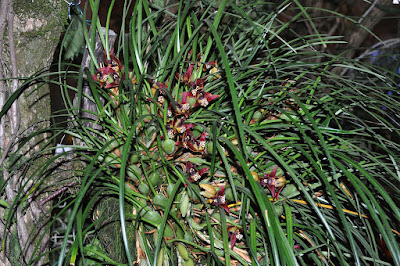Maxillaria tenuifolia is native to Mexico, Guatemala, Belize, El Salvador and Nicaragua. These plants grow in rainforests, in tropical forests with trees partly losing leaves, and sometimes also in ravines in warm oak forests. They are found at low altitudes from the sea level to approx. 1000 m...
Maxillaria tenuifolia also called as The Coconut Orchid, The Delicate Leafed Maxillaria, Maxillaria gracilifolia, Maxillariella tenuifolia, is a species of the genus Maxillaria. This species was described by John Lindley in 1837.
IDENTIFY MAXILLARIA TENUIFOLIA
Maxillaria tenuifolia is native to Mexico, Guatemala, Belize, El Salvador and Nicaragua. These plants grow in rainforests, in tropical forests with trees partly losing leaves, and sometimes also in ravines in warm oak forests. They are found at low altitudes from the sea level to approx. 1000 m.
The Coconut Orchid is a medium sized, cool to hot growing, solitary leafed epiphyte or occasional terrestrial with an ascending growth habit, which growing up to 60 cm in height, with a rhizome that is completely enveloped by scarious, imbricating, nonfoliaceous bracts with oblong-elliptic to oblong-obovate, compressed, 2-6 cm long and 1-2 cm wide pseudobulb with a single apical, linear, attenuate, 12-50 cm long and 0.2-0.7 cm wide leaf.
The Delicate Leafed Maxillaria blooms on a 5cm long, single flowered inflorescence arising on a mature pseudobulb with scarious, basal bracts with the flower held at mid leaf height and occurs in spring and summer. The flowers with a width of 3.8-5.0 cm have a very distinct texture and smell of coconut. Their color is slightly variable, but usually the petals of both whorls are dark red and have light or dark yellow marbled patterns. The concave lip is dark, deeply blood-red from the base to the half-length, while its apical part is dark yellow with red-purple or red-brown spots forming a leopard pattern. The beer-yellow prong has dark red spots on the front.
MAXILLARIA TENUIFOLIA CARE AND CULTURE
Cultural information should only be used as a guide, and should be to be adapted to suit you. Your physical location; where you grow your plants, how much time you have to devote to their care, and many other factors, will need to be taken into account. Only then can you decide on the cultural methods that best suit you and your plants.
Light:
Maxillaria tenuifolia needs a light level of 15000-20000 lux. The light should be filtered or dispersed, and plants should never be exposed to direct sunlight. Strong air movement should be ensured all the time.
Temperature:
It is a thermophilic plant. The average temperature of the summer day is 28-29 ° C, and the average night temperature is 19 ° C, with a daily amplitude of 9-10 ° C. In winter, the average daytime temperatures are 23-24 ° C, and the night 13-15 ° C, with an amplitude of 9-10 ° C.
Humidity:
The Delicate Leafed Maxillaria needs the average humidity of 80% throughout the year.
Substrate, growing media and repotting:
Maxillaria tenuifolia grow well attached to pieces of tree ferns or cork, with high humidity and requires daily watering during the summer. During the dry and hot periods it may be necessary to water several times a day.
The Coconut Orchid can also grow in pots using a loose substrate that quickly drains excess water, but contains substances that retain a certain amount, such as sphagnum moss and perlite. Wood charcoal is also often added to ensure the air permeability of the substrate and protection against acidification.
Watering:
In the period from late spring to autumn rainfall is moderate to heavy. During the active growth, the cultivated plants should be kept in moisture, with only slight drying between waterings. In the autumn, watering should be gradually reduced.
Fertilizer:
During the period of strong growth, the plants should be fertilized every week with 1/4-1/2 of the recommended dose of balanced fertilizer for orchids.
At the beginning of the year, when the period of intensive growth, you can use nitrogen enriched fertilizer. In late summer and autumn, use fertilizers with a high content of phosphorus to stimulate plants to flower.
Rest period:
In winter, watering for Maxillaria tenuifolia should be limited, but must not be allowed to dry up too much or remain dry for a long time. Fertilization should be limited or should be completely abandoned until spring, when stronger watering resumes.

















Thank you for all your articles on so many species.
Delete